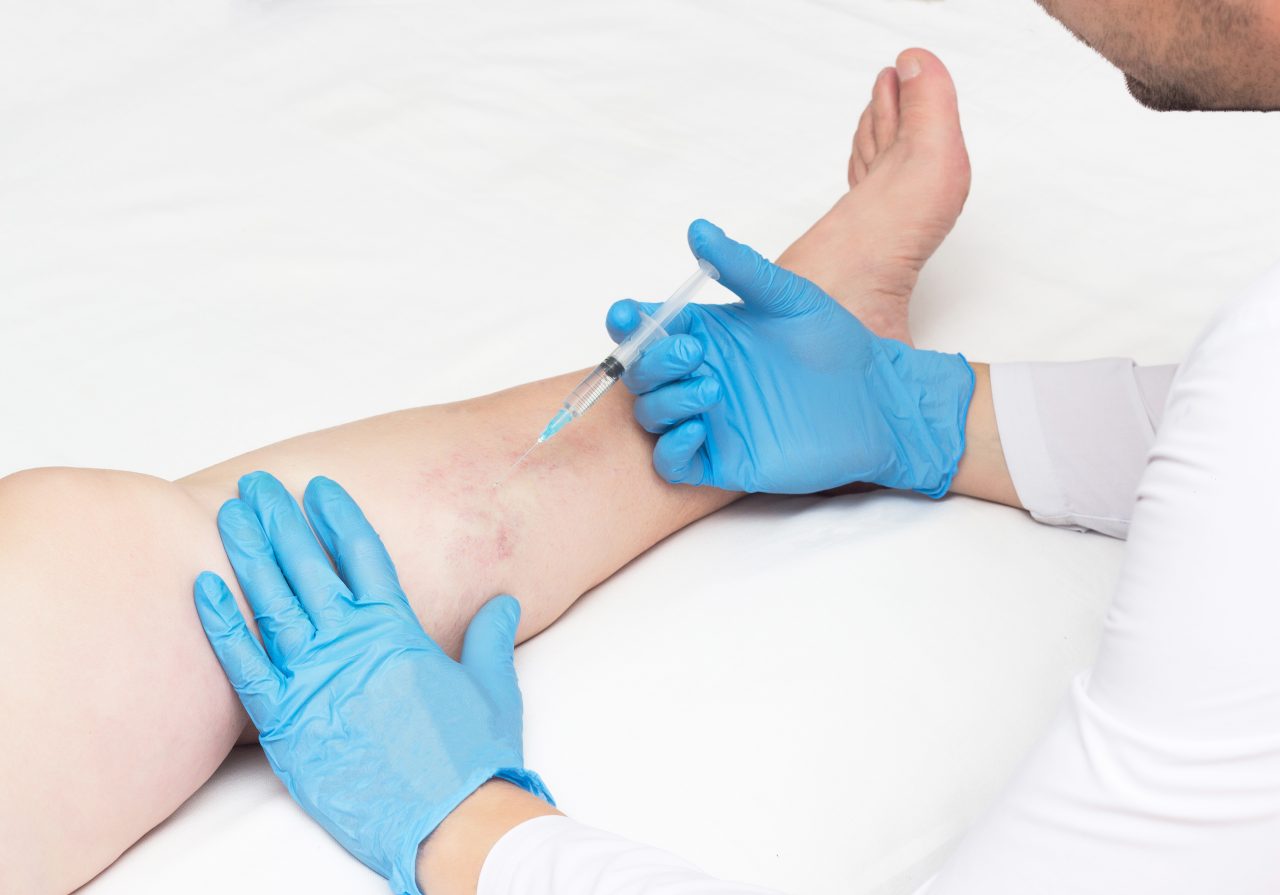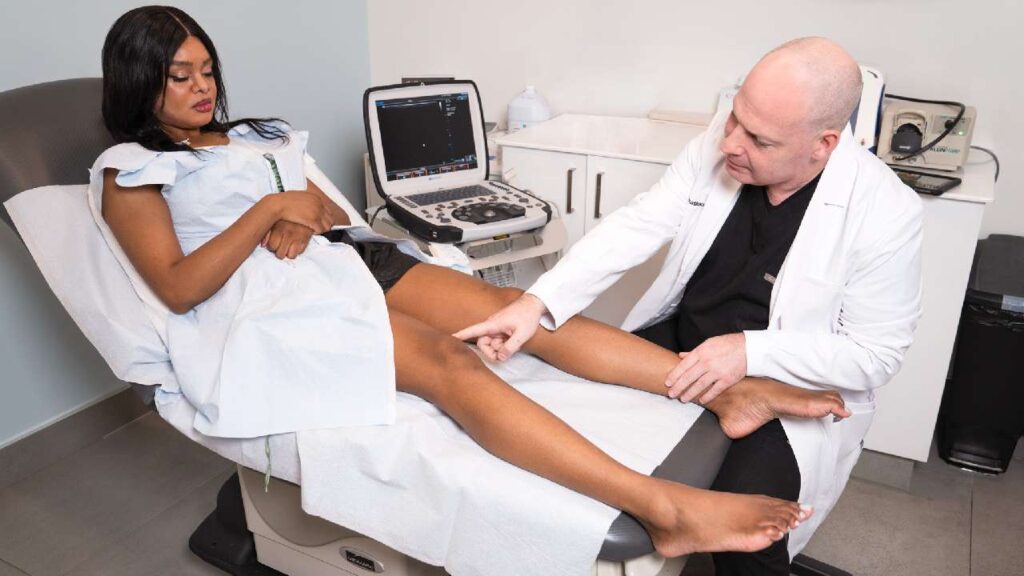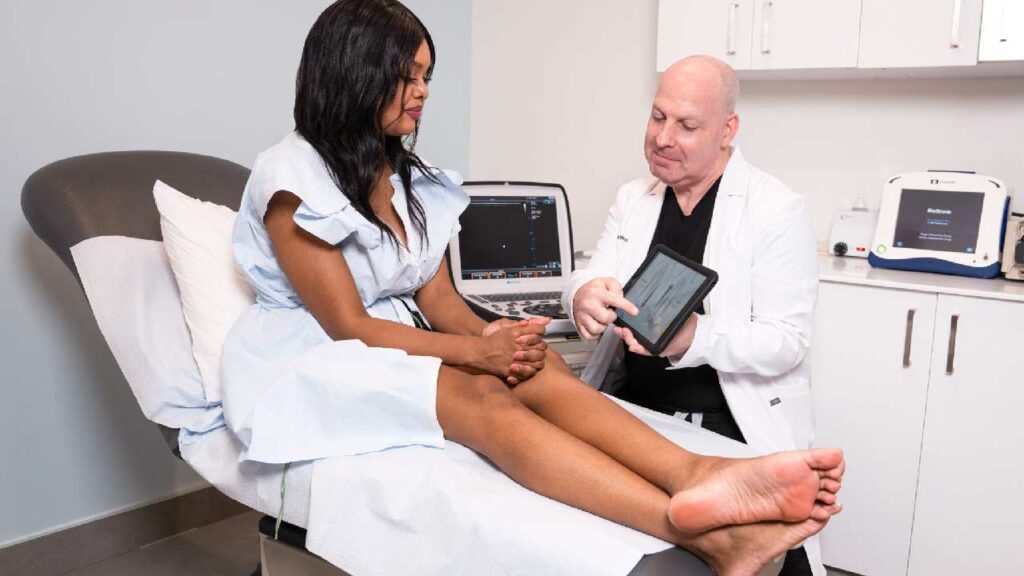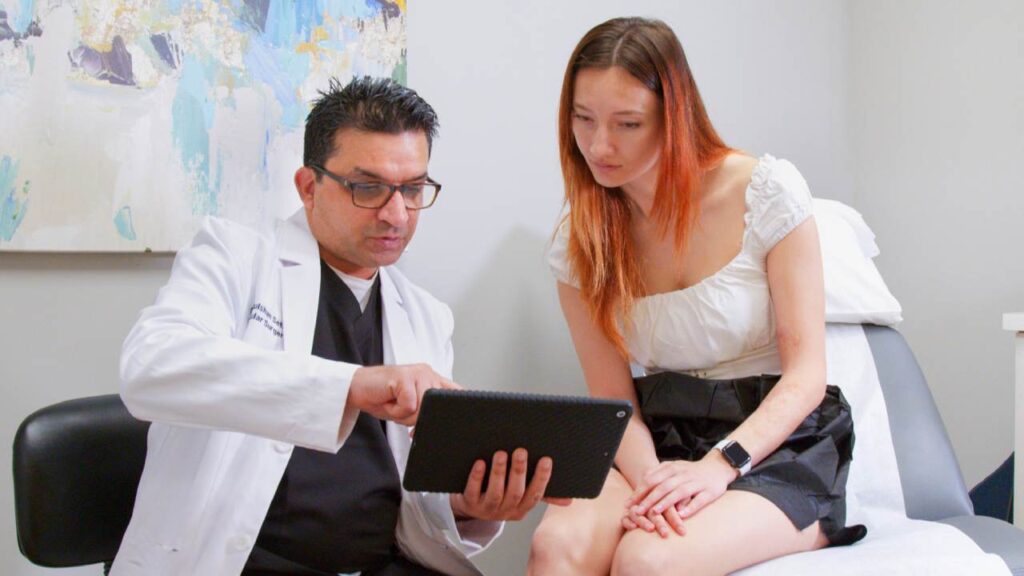What Problem with Vein Anatomy Causes Varicose Veins?
Varicose veins are caused by a buildup of pressure inside the vein. This happens when a vein valve fails to close properly. Veins have three layers, and the innermost layer of many veins is lined with valves that seal once blood flows through. A tight seal on the valves is what keeps blood moving in the right direction. When a valve malfunctions, blood flows in reverse, engorging the vein. The vein begins to twist and swell, creating the bulging varicose veins you see at the skin’s surface.
The more backward blood flow you have, the more your vein walls stretch to accommodate blood. As veins stretch, they prevent valves from closing tightly too, even if they aren’t broken. This common issue is called Chronic Venous Insufficiency, and it can become debilitating. Book an appointment with Harvard-trained vein doctors to determine what’s causing your varicose veins. If you have Chronic Venous Insufficiency (CVI), you must treat it, in addition to treating varicose veins, to prevent continual issues. Some things put you at increased risk of developing varicose veins, including these contributing factors.

Risk Factors for Varicose Veins:
- Family history
- Female hormones
- Hormonal changes
- Birth control usage
- Pregnancy
- Obesity
- Sedentary lifestyle
- Smoking
Why Is the Anatomy of Veins in Legs More Susceptible?
Varicose veins are particularly common in the legs. This is because leg veins must pump blood from the feet all the way to the heart, so they have a tougher job than other veins. In addition, they must resist gravity and bear our body weight while they try to return blood to the heart. This makes vale failure more likely. People who must sit or stand for long periods of time also exacerbate leg veins. Blood pools and regresses more easily when we sit or stand, than when we elevate legs and feet.
In addition, movement creates muscle contractions in the legs that help pump blood out of leg veins. So, when we remain in a stationary position, we reduce the number of those helpful contractions. If your job requires you to sit or stand for long periods, take breaks to stretch, prop your legs and feet up, or walk around the office. If you must remain in place, do seated or standing calf raises, make circles with your ankles, or march in place to prevent blood accumulation.
Is a Popped Vein in Wrist or Face Caused by the Same Thing?
Varicose veins can appear in many parts of the body. But they aren’t common in the wrist or face. If you see a vein popping out on your forearm or forehead, it could signify valve failure, but it could also be visible due to thinner skin in those areas. It’s normal for some people’s forehead or wrist veins to bulge with natural increases in blood pressure.
Things that make blood vessels naturally expand include hot showers, exercise, hot or cold weather, stress, and straining. If the vein shrinks again once those factors are removed, and if the vein is not twisted, rope-like, boldly-colored, or painful, it might not be varicose. Only a vein doctor can determine this, so book a vein consult today. If it’s a healthy vein, but you don’t like how it looks, we offer treatment options for that too.
Varicose Veins vs Stretch Marks: Do They Share a Cause?
Varicose veins and stretch marks aren’t caused by the same thing, but they can develop at the same time. Pregnancy expands the veins, as well as the abdomen. So, it’s common to acquire varicose veins and stretch marks while pregnant. Pregnancy doubles blood volume, which stretches veins, making it more likely for valves to fail. And as the uterus grows, it puts more pressure on pelvic veins, which can make them varicose too.
Rapid or significant weight gain for any reason, not just pregnancy, can cause both varicose veins and stretchmarks. When the veins are overstretched, varicosities ensue, and when skin is overstretched, stretch marks ensue. These two issues require different treatments, and vein treatment is more essential than treating stretch marks, which often fade on their own. Sometimes weight gain is necessary, as with pregnancy. But if you are able to maintain a healthy weight at other times, it will reduce the likelihood of acquiring varicose veins.
Do Varicose Veins Require a Vein and Pain Treatment Clinic?
Some varicose veins remain asymptomatic. But many produce significant issues. Symptoms range from cramping, swelling, and heaviness to serious problems like venous ulcerations, venous stasis dermatitis, and profuse bleeding. Hyperpigmentation, infection, and blood clots are also possible. You can’t self-diagnose or self-treat Chronic Venous Insufficiency or valve failure. You need a vein and pain treatment clinic to conduct an ultrasound exam. These tests are quick and painless and can prevent a host of severe complications.
Is a Surgical Doctor or Varicose Veins Specialist Best?
Varicose veins rarely require vein surgery in 2023. Advances in minimally invasive technology have moved surgery down the list of recommended treatments. Choose a vein specialist before a surgeon to avoid unnecessary surgery. However, if the vascular surgeon is also trained in minimally invasive procedures, they’re a good choice too. The best vascular surgeons reserve vein surgery for complicated cases.
How Do Award-Winning Vascular and Vein Centers Treat Veins?
Award-winning vein clinics use cutting-edge technology, like ultrasound-guided procedures, for precise, non-surgical treatment. The methods include sclerotherapy, radiofrequency ablation, endovenous laser ablation, mechanochemical ablation, vein adhesives, and surface lasers. These procedures are performed in the office without general anesthesia. Patients can complete treatment in 15-30 minutes and head back to their usual routine. Several of these methods treat what causes varicose veins, in addition to treating varicose veins.
What’s the Collapsed Vein Treatment or Sclerotherapy Meaning?
Are you wondering what “collapsed vein treatment” and “sclerotherapy” mean? Minimally invasive varicose vein treatments intentionally collapse or close unhealthy blood vessels. One way they do this is by injecting a sclerosant that irritates the vein, creating scar tissue that seals it shut. This is called sclerotherapy. Another method injects cyanoacrylate glue to collapse the vein. And some treatments eliminate veins by heating them. Each of these methods is gentle and non-invasive, and there is no downtime involved.
How Much Is Varicose Vein Treatment in NY?
If you choose a board certified vein doctor at an accredited vein clinic, treatments are often covered by insurance. Our state-of-the-art vein clinics are fully accredited, and our certified physicians use FDA-approved methods that insurance companies recognize. We have the ultrasound technology to prove medical necessity for your treatment. And we file paperwork for you, ensuring your coverage before your appointment.
This is not the experience you’ll have at a dermatological or cosmetic vein clinic. They don’t possess the technology to prove medical necessity or to treat CVI or large varicose veins. So, procedures in these clinics are typically deemed elective. These treatments cost several thousand dollars.
Which Clinic Provides Affordable Leg Vein Removal Near Me?
For affordable leg vein removal near you in NYC, visit our premier vein clinics in Midtown or the Financial District. Or visit our clinic in Hartsdale, NY. We remove varicose veins and spider veins quickly and gently, without surgery. We also educate patients on how to prevent varicose veins from developing again. Book your consultation today. We’ll see you soon!





